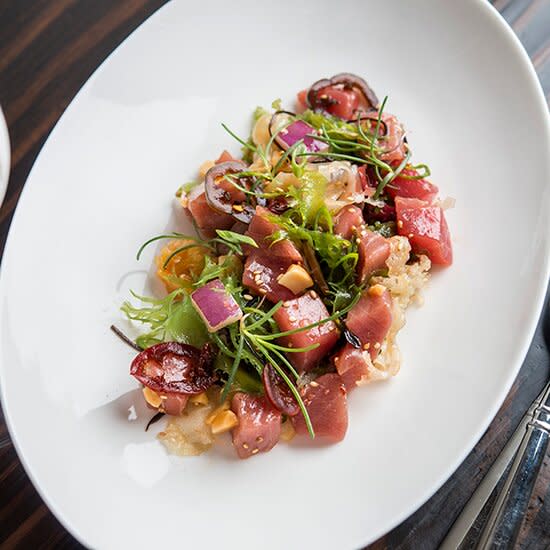7 Things You Need to Know About Poke

© Evan Sung / Noreetuh
The raw tuna salad known as poke certainly isn't a new creation, but lately we've been seeing versions of it everywhere—even stuffed into a burrito. One of our favorite new versions is on the menu at Noreetuh, a new Hawaiian restaurant in New York's East Village run by three Per Se alums, Chung Chow, Jin Ahn and Gerald San Jose. We caught up with chef de cuisine (and Hawaii native) Chow for a primer on all things poke.
First of all, what is poke? Is it a dish with a clear origin story?
The word poke simply means "chunk" in Hawaiian. That said, in the past poke was typically any meat or seafood that is cut into small chunks and marinated. When referring to poke nowadays, it is generally seafood. It's unclear exactly what the origin is, though many agree that chunks of marinated seafood have been consumed for a long time by locals, and if you ask anyone from Hawaii such as myself, I've known poke all my life and just grew up eating it.
What is the proper way to pronounce poke?
Poke is pronounced (poh-KAY) and rhymes with okay.
Is there one generally agreed-upon style, or are there regional variations?
Generally speaking, poke would refer to raw pieces of tuna cut into cubes, then marinated with soy sauce and sesame oil and mixed with onion; though the variations go far beyond this generalization. Poke doesn't necessarily have to be tuna or even seafood, nor does it have to be raw or cubed. If can be cooked or raw, cubed or scraped, and doesn't even have to be fish or seafood. Cubed avocado is sometimes used. If you go to a local grocery store in Hawaii, poke is a staple, and there are endless varieties including poke made using octopus, poke that is dressed with a creamy mayonnaise and poke garnished with kimchi or wasabi, resulting from the strong influences of Japanese and Korean cuisines.
Can you tell me a little about the philosophy behind Noreetuh and how poke fits into that?
Noreetuh's menu celebrates the wide spectrum of Hawaiian cuisine—from the play on the traditional musubi using corned beef tongue in place of Spam to the bigeye tuna poke, which stays true to what you would see in Hawaii. In addition to some of the more widely known elements that some may even deem kitschy, my team and I want to also explore the elements of Hawaiian cuisine that may not be so obvious, like the strong influences of Japanese, Korean, Filipino and even Portuguese cuisines on the Hawaiian table.
How do you make your poke?
The poke served at Noreetuh starts with cubes of raw sushi-grade bigeye tuna loin. It's garnished with red onion, scallion, various types of seaweeds for texture and toasted macadamia nuts for crunch. The predominant flavors in the dressing are soy sauce and sesame oil, but we also add tobanjan, a spicy Japanese condiment made from chile and broad beans. Slices of soy-pickled jalapeño peppers add a savory kick.
Poke seems to be having a bit of a moment. Why are people paying more attention to it now?
As a Hawaiian, it's very exciting to see dishes from my childhood growing in popularity in the country and particularly in New York City, where I live. The American palate for Asian cuisines has grown dramatically over the last couple decades—first Chinese and Japanese, now Thai, Korean and Filipino. It's only natural that Hawaiian cuisine, which is directly influenced by many of the aforementioned cultures, would slowly gain in popularity. Not only is the cuisine gaining more popularity, but the idea of Hawaii as a culinary destination has also taken root with the pedigree of the chefs from restaurants such as MW Restaurant (Michelle and Wade Ueoka) and Vintage Cave (formerly Chris Kajioka from Per Se and Aziza and currently Jonathan Mizukami from The French Laundry), which also helps.
Do you have any tips on how to make a quality poke at home?
For a traditional ahi poke using bigeye or yellowfin tuna, the most important factor is using very fresh sushi- or sashimi-grade fish. Check with your local fishmonger specifically for sushi-grade tuna when you plan on making poke using raw fish. Beyond that, the seasoning and other elements that bring flavor and texture is really to your personal preferences. I enjoy a classic soy sauce and sesame oil seasoning and dressing the poke with crunchy seaweed and macadamia nuts.
